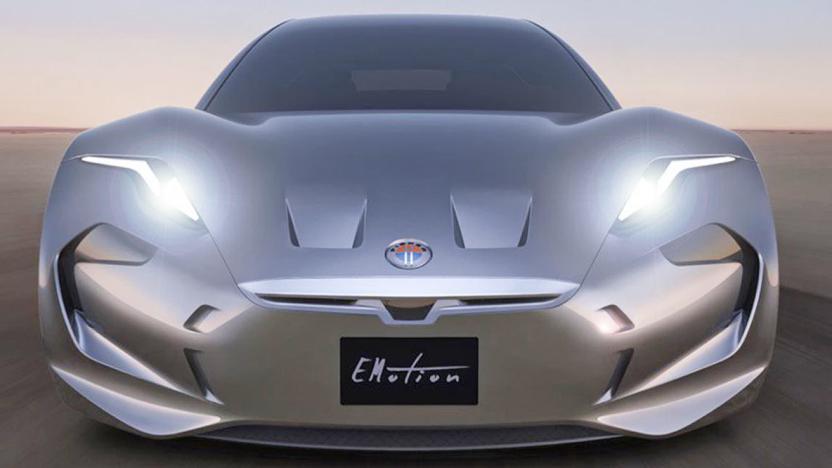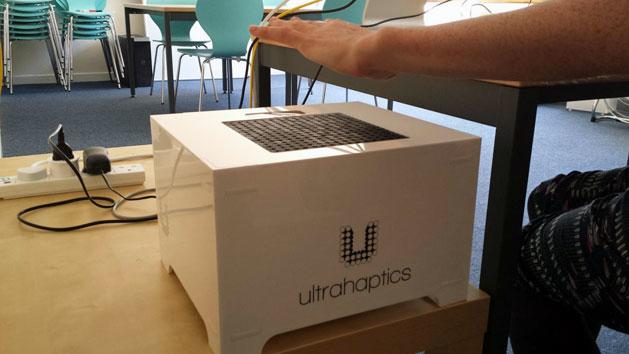emotion
Latest

Amazon is reportedly working on an emotion-detecting wearable
Amazon is reportedly working on a wrist-worn gadget that's able to detect your emotional state. The device would pair with a smartphone and use microphones to perceive your emotions from your voice, Bloomberg reported. The device would eventually be able to offer suggestions on how to better interact with other people, according to internal documents.

Emotional robot uses goosebumps to show how it's feeling
Sure, a robot can show how it's feeling (insofar as a robot can feel) with its face, but that's not the only way living beings do it. Humans have their goosebumps, for instance, while cats and dogs will raise their fur. Cornell wants to bring that nuance to synthetic beings. Its researchers have crafted a robot that uses a soft, adjustable skin to provide a tactile indication of a robot's emotion -- as the university put it, you can feel its feelings. It may develop goosebumps if it's happy, spikes if it's angry, or just a timid response if it's sad and needs a hug.

Microsoft's latest acquisition focuses on social education
Education these days isn't just about reading, writing and arithmetic -- it's also about learning how to learn. And Microsoft wants to be the go-to option for teaching these abilities. It's buying Flipgrid, the creator of an educational platform that fosters social-emotional skills like communication and bouncing back from failure. The tech giant hasn't said how it will integrate Flipgrid with the rest of its lineup, but it's starting by making the platform free to schools (they can get prorated refunds if they've subscribed).

'Sea of Solitude' pits players against overwhelming loneliness
EA surprised the audience during its E3 2018 press conference on Saturday, announcing the upcoming release of "Sea of Solitude" from Berlin-based studio Jo-Mei games.

Fisker’s luxury EV will debut in January at CES 2018
Legendary car designer Henrik Fisker has announced when we'll finally get to lay eyes on his electric luxury EMotion sedan in person. The car will debut in January at CES 2018. As Fisker told TheStreet, the team behind the vehicle will also introduce some of the tech behind the EMotion, like its battery pack and LIDAR technology for autonomous driving, though that's still in development. The battery can reportedly charge in just nine minutes and the car has a 400 mile range.

Legendary car designer Fisker unveils his new luxury EV in August
Henrik Fisker has already dropped a few hints about his EMotion luxury electric car, but you now know when you'll get to hear the rest. The automotive design legend has revealed that his namesake company will formally unveil the EMotion on August 17th. Not that you'll have to wait too long to know what the fuss is about, as Fisker is already spilling the beans on key details.

Fisker's EMotion sports car, and more in the week that was
Tesla swept headlines this week by launching a groundbreaking solar roof tile that's better looking and longer lasting than standard shingles. The technology could trickle down to the company's cars too -- Elon Musk hinted that the upcoming Tesla Model 3 could feature a solar roof that melts ice and snow while generating energy from the sun. Meanwhile, legendary automotive designer Henrik Fisker finally unveiled his EMotion sports car, which will be able to drive 400 miles on a single charge when it launches next year. Nissan debuted the first all-electric mobile office, which is housed in a beautifully renovated e-nv200 van. And a Chinese company is getting ready to launch the world's fastest maglev train, which will be able to hit 373 miles per hour.

The Morning After: Wednesday November 2nd, 2016
Yes, it's the start of hump day, but you may have missed Google revealing unpatched Windows 10 bugs, the truth of the dark web and (in cheerier news) our beautiful Engadget Holiday Gift Guide. We also take a closer look at Xiaomi's plan to become more than just the king of budget smartphones.

Henrik Fisker unveils his ambitious EMotion luxury EV
Henrik Fisker has tweeted some new images of the EMotion electric car from Fisker Inc. with a theoretical 400 mile range and 161 mph top speed. Overall, it looks like a softer version of the original Fisker Karma EV from the side, with a grill-less snout like the Tesla Model S. The technical highlight is a new type of graphene battery, under development at UCLA, that (theoretically) charges faster than a lithium-ion model. The vehicle is slated to be built at an "existing facility," reportedly in California, and unveiled in 2017.

QWERTY keyboards change how you feel about words
The keyboard is mightier than the pen for written communications nowadays, and that apparently has a large impact on how we feel about words. A good example is the QWERTY effect, where words from the right side of the keyboard supposedly have more positive associations. For instance "hunky pinup" typed with the right hand supposedly makes you feel better than the left-side only phrase "sweet dress." Swiss and German researchers have concluded that the effect works all over the web, and applies to product names, film and book titles, and video clips.

Scientists identify neurons that help you process emotions
Scientists just got one step closer to understanding the nuts and bolts of how your mind handles emotions. An MIT team has identified two neural connections in the brain's amygdala regions that process positive and negative emotional events. By tagging neuron groups with a light-sensitive protein, they discovered that the neurons form parallel but complex channels that respond differently to given situations. Some neurons within one of those connections will be excited by a feeling, while others will be inhibited -- the combination of those reactions in a given channel may determine the emotion you experience.

IBM's Watson can sense sadness in your writing
Artificial intelligence won't be truly convincing until it can understand emotions. What good is a robot that can't understand the nuances of what you're really saying? IBM thinks it can help, though. It just gave Watson an upgrade that includes a much-improved Tone Analyzer. The AI now detects a wide range of emotions in your writing, including joy or sadness. If you tell everyone that you're fine when you're really down in the dumps, Watson should pick up on that subtle melancholy. Watson is also better at spotting social tendencies like extroversion, and studies whole sentences (important for context) rather than looking at individual words.

Apple buys AI firm that detects emotions in facial cues
If it wasn't already clear that Apple is getting serious about artificial intelligence, it is now. The company has confirmed that it bought Emotient, a fledgling outfit that uses AI to gauge emotions based on facial expressions. As usual, the Cupertino crew isn't saying what its plans are. However, Emotient's specialty is in detecting your overall sentiment, like contentedness or frustration. Combined with the AI-powered assistant tech from VocalIQ, it wouldn't be shocking if Apple is working on helper software that genuinely understands your moods and reactions. There's certainly pressure to do so -- with both Facebook and Google working on AI-driven chat assistants, Apple might not want to feel left out. [Image credit: Getty Images]

This box transmits emotions to your hand
This slightly unwieldy looking machine can apparently deliver emotions to your hand through "mid-air haptics", pinpointing areas on your palm that are attuned to certain emotions, and stimulating them. A study from the University Of Sussex used an Ultrahaptics system to communicate emotions between test groups, with the haptic group stating significantly higher stimulation compared to a test group that was only shown a picture. (Mere optical stimulation? Pssch.) Dr Marianna Obrist, Lecturer at the Department of Informatics, has apparently figured out that stimulating different areas of the hand conveys different things: hot bursts of air to the area around the thumb, index finger and middle part of the palm generate excitement, while sad feelings can be delivered by slow and moderate stimulation on the outer palm and areas around the little finger.

This skin-sensitive controller ramps up game difficulty when you're bored
The concept of using your emotional state to alter gameplay is nothing new, but the technology to make that happen has frequently relied on cameras and other special add-ons. Stanford University's Corey McCall has a far more elegant solution -- he recently developed technology that builds skin-based emotion detection into an otherwise ordinary gamepad. The controller changes the intensity of a game based on the feelings you convey through breathing, heart rate and motion. It can boost the difficulty level if you're obviously bored, or tone things down if you're taking a challenge way too seriously. There may not be a great need for McCall's approach when systems like the Xbox One can check your pulse at a glance, but it could let console and peripheral makers offer emotion-aware gaming without requiring cumbersome (or costly) extras.

Emotient's Google Glass app tells you how others are feeling
It's not always easy to read someone's emotions -- and that's a problem for retailers, which can't easily tell if their products intrigue you or simply confuse you. They may not have to guess for much longer, though, as Emotient has launched the private beta for a Google Glass app that identifies feelings using the device's camera. The software scans faces for emotional cues that reflect an overall sentiment, even if it's subtle; the app can tell if you're mildly pleased, for instance. Privacy shouldn't be an issue, since the app is only saving anonymous data, not images. Emotient is testing its app with just a handful of companies right now, but the finished app should help stores please customers in the future. There's also a chance you'll see the underlying technology in something you can try for yourself. The company tells The Next Web that its emotion detection will reach Intel's RealSense platform, so don't be surprised if your next webcam can tell that you're in a good mood.

Intel's 3D camera technology detects emotions and eyes, gives Kinect some competition
We know that Intel sees 3D cameras as the future of computing, and the company's Anil Nanduri just provided a few hints of what that future may involve. He tells Network World that the depth-sensing technology can recognize emotions, such as happy smiles. It can also track your gaze; a camera can detect when readers are stumped by unfamiliar words in a book, for example. The technology's shape detection is accurate enough that it can even scan objects for 3D printing. We won't get a true sample of the technology's potential until Creative ships its Senz3D camera before the end of the current quarter. Nonetheless, it's already evident that Microsoft's next-generation Kinect for Windows will have some real competition on its hands.

Facebook adds new emotion selection tool, making it easier to converse
See that? That's a new feature on Facebook's status box, which has started to roll out this morning after earlier testing in January. It's also covering up a pretty depressing note from a friend underneath, who would've undoubtedly selected "sad" if he were to have recognized said feature before posting a conventional status update. For now, it appears that the emotion selection tool is only hitting select US-based users, as our European contingent has yet to see it appear on their profiles. Essentially, a smiley face has been added to the right of the photo button, and pressing it gives you a quick way to update your status -- you can share an emotion, or what you're watching / listening to / reading / drinking / eating. It seems as if Facebook wants to funnel conversations a bit; instead of only giving you free rein to blabber in a status box, it'd much rather you update with a linked artist, television show or product. That way, said entity gets included in any conversations you have, and the great revenue wheel begins to spin. At any rate, feel free to check your own page and play around with the new functionality. Then shoot us an emoticon in comments to let us know how you're feeling about it. %Gallery-185095%

CES: HeartMath's Inner Balance helps you find your center
HeartMath is a company that's been dealing with emotional health and stress relief for several years. While I don't go in for measuring one's emotional state with a gadget, I have to say that visiting HeartMath's booth here at CES 2013 was very disarming. They sat me down, and plugged a clip on my ear that was connected to an iPhone. This is HeartMath's new Inner Balance device, an iPhone-enabled heart rate variability detector that works in conjunction with HeartMath's app to try and reach some sort of emotional center. There is some science here. The ear clip does monitor heart rate information (although accuracy can't really be expected from a measurement like that). When you begin a "session," you're asked to choose your current mood from a wheel of smiley faces. The app then goes into a "breathing" mode and displays a graphic meant to help you breathe easier and relax. As time goes on, the app tracks a few status figures from your body, and fills in a circle with red, blue or green segments, depending on how much more relaxed your body is getting. My circle started red, and then went blue and green pretty quickly, as I focused on my breathing the iPhone's display. I must admit, despite what seemed a lot like pseudoscience to me (though HeartMath's rep shrugged off any suggestions that this was anything but legit), the breathing did seem to help calm me, even on the noisy floor of CES. Once I was calm, the display stayed green, showing that I was making progress. At the end of the session, I was asked to choose from another wheel of smilies, and I choose a face slightly more smiley, indicating that the device had worked. You can log a journal entry for each session, describing how you felt and how it worked. You can also track your progress over time, seeing if the device makes you feel calmer from point to point and session to session. Obviously, there are no guarantees here. Like so many other stress relief products, Inner Balance's effectiveness depends, more or less, on your belief in it. Personally, I get just as much stress relief out of a great iPhone game as I would an app like this, I think. But for the right person, Inner Balance could indeed help you to achieve the state it's named after. The device should be available in February, according to HeartMath, for a price of US$99.

MMO Blender: Eliot ponders a fantastical fantasy
Fantasy, at this point, is almost tragically boring. That seems like a contradiction in terms. A fantasy setting is supposed to be fantastic by its very definition; you should be surrounded by neat and astonishing things at every term, immersed in a rich and baffling setting where magic is a valid explanation for almost everything. Unfortunately, we've seen so many versions of the same old fantasy setting that it's become boring. It's another round of the same elements with slightly different names, and while you can give them floppy ears and call them Asurans, they're still just gnomes with better public relations. So let's stick a fork in it and say we're done... or maybe not. There's some fantasy out there that could be collected into an interesting state, I think, something a bit further afield of the bog-standard elves and humans and dwarves dealing with dragons and whatever else. So let's mash this stuff up in a blender and see if we can't come up with some fantastic fantasy again.








